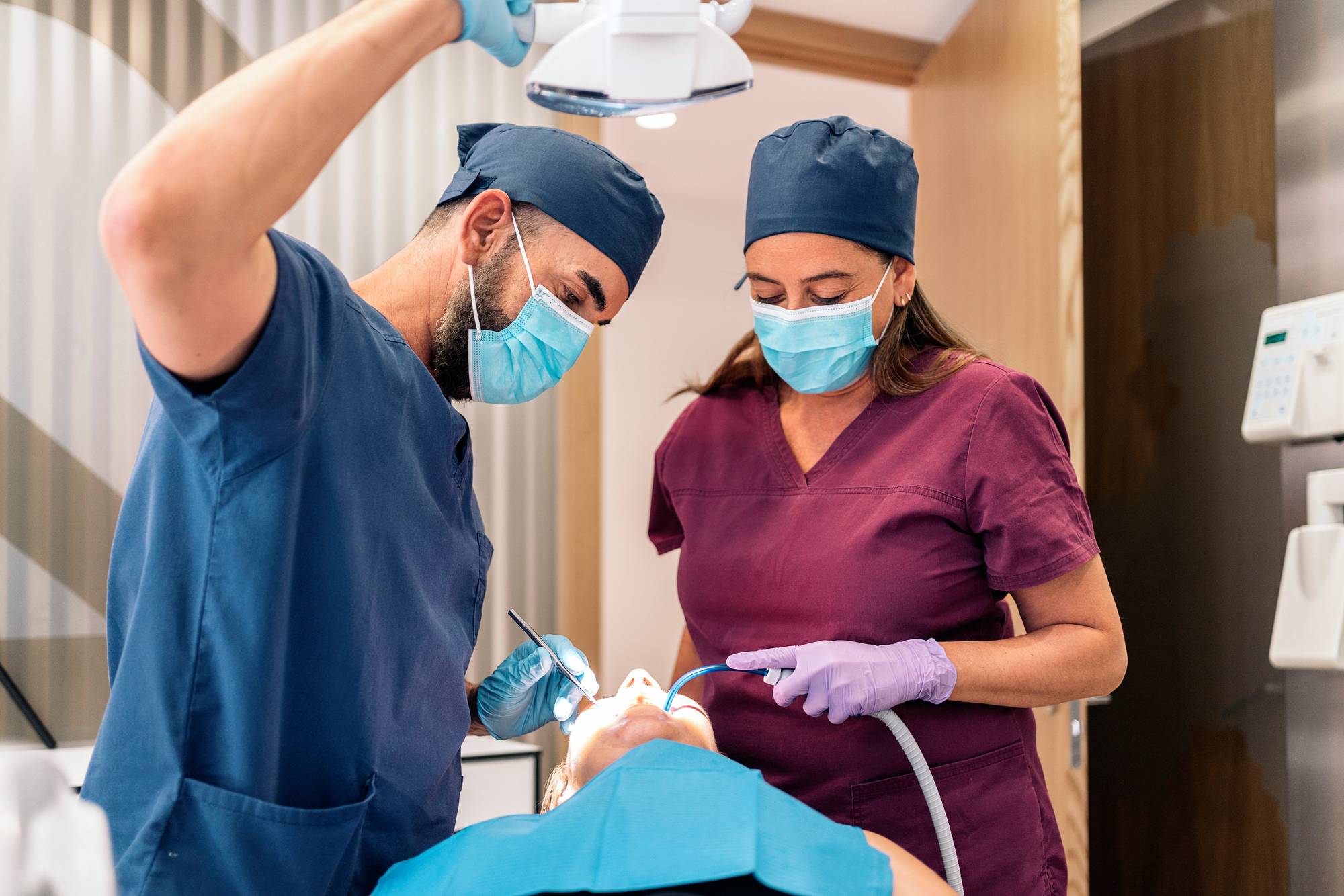You may also be an aspiring dental professional looking for the best opportunities. Should you focus on becoming a dental hygienist or dental assistant? Is it possible to become both? How much will you earn?
Let’s face it, dental assistants and hygienists have some shared roles. However, there are notable differences. Below we’ll highlight the 4 main ones, starting with some definitions.
1. Technical Differences
Who is a Dental Assistant? What Do They Do?
Dental assistants are essential members of a dental team. They provide chairside assistance to dentists during various procedures, ranging from simple cleanings to complex surgeries. In addition to this, they manage administrative tasks in a dental practice, such as record-keeping, managing inventory, and ordering supplies. Dental assistants can work in general settings or specialize in surgical assisting, providing support during oral surgeries and other complex treatments. Overall, dental assistants are critical to the success of dental practices.

As a dentist or dental employer, dental assistants are here to support you, your patients, and other dental professionals in your practice i.e. dental hygienists.
Who is a Dental Hygienist? What Do They Do?
Dental hygienists provide preventive oral care to patients, such as cleaning teeth and gums, removing plaque and tartar, and applying fluoride treatments. They also assist dentists during procedures and educate patients on proper oral hygiene practices. Their work promotes oral health and prevents dental disease.
In addition to the tasks mentioned earlier, dental hygienists also take and develop dental X-rays, assess patients’ oral health conditions, record and update patients’ medical histories, and administer local anesthetics to patients. They work closely with dentists to develop and implement treatment plans for patients with oral health conditions, and they may also refer patients to specialists such as periodontists or orthodontists for further treatment. Overall, dental hygienists are critical members of the dental team, and their work helps to ensure that patients receive the best possible care for their oral health.
2. Differences in Education Requirements
Dental Assistant Training/Education
The CDAA (Canadian Dental Assisting Authority) is the body mandated with regulating dental assistants in Canada⁵. While each territory and province in Canada may have some different requirements on educational and licensing requirements for dental assistants, there are some basic requirements:
- Completion of an accredited training program that takes approximately 1 year to complete: One must have completed high school and have proficiency in science (more so chemistry and biology) to take the accredited training program for dental assistants.
- Additional training or requirements: Some dental assistant programs may require additional CPR certification (cardiopulmonary resuscitation certification).
- License (in most provinces): A license is also required for most dental assistants to start practicing since the profession is considered a restricted healthcare occupation. To get a license, one must pass the NDAEB exam¹.
Dental Hygienist Training/Education
Dental hygienists are also regulated based on jurisdiction. However, there are typical educational requirements that include:
- A diploma in dental hygiene lasting for approximately 2-3 years or a bachelor’s degree (in dental hygiene) lasting for approximately 4 years². One needs a high school diploma (with focus on sciences, Mathematics, and English) to take a dental hygiene program. The program in question must also be from an accredited institution³.
- NDHCB certification exam and registration: Dental hygienists are also generally required to pass the NDHCB exam⁴. They need to be registered by the applicable dental hygiene authority in their territory or province to begin practicing.
- Additional requirements: Most jurisdictions will also require dental hygienists to take professional development programs yearly to continue practicing.
Understanding the educational requirements and additional requirements is important for identifying the best dental assistant and dental hygienist candidates from the rest.
3. Differences in Average Salary
Dental Hygienist Vs Dental Assistant Salary
There’s also a difference in median salary which is based on the level of work done. Dental hygienists do more advanced work than dental assistants and they also meet more stringent educational requirements, which means they are eligible for higher wages.
In Canada, the national average pay for dental assistants is $25 per hour⁵ while dental hygienists earn approximately $45 per hour⁶.
The above salary average should guide you when planning to hire a dental assistant or dental hygienist in Toronto. However, it’s worth noting that salaries vary based on jurisdiction, experience, and benefits like medical, optical, and dental coverage.
DentiMatch: Leading Platform for Highly Experienced Dental Assistants and Dental Hygienists in Toronto.
Now that the roles of dental assistants and hygienists have been outlined., you are ready to hire the right dental professional to meet your office needs. But where can you find them?
You can use DentiMatch – a cutting-edge dental staffing platform in Toronto that connects those looking to fill dental jobs i.e., dentists and dental offices with highly qualified dental professionals like dental assistants and dental hygienists
Most importantly, the platform can be used for filling temporary job openings quickly and easily in a few simple steps.
To fill a position in your dental practice, sign up & post a dental hygienist or dental assistant job. Alternatively, sign up and find a dental hygienist or dental assistant job.
For more information, email support@dentimatch.com or fill DentiMatch’s online contact form.
References





